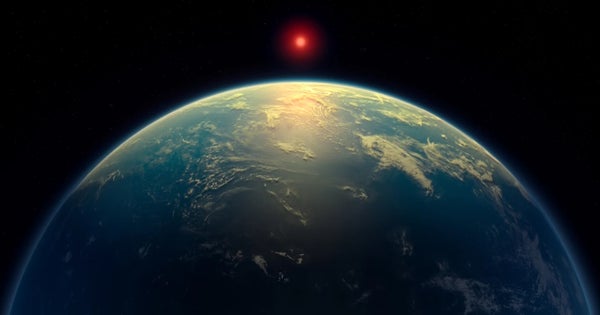K2-18B
1. Context
On April 16, an international research team uploaded a paper in which it reported that the distant exoplanet K2-18b may be habitable. The claim was met with cautious excitement by astronomers. While finding places in the universe that could harbour life is a vital quest in the field, experts — including the team that made the finding — are cautious because many similar claims in the past have had to be retracted after closer inspection.
2. What is K2-18b?

K2-18b is an exoplanet, meaning it lies beyond our solar system. Situated about 124 light-years from Earth in the Leo constellation, it orbits the star K2-18. This planet is approximately 5.2 times broader and nine times more massive than Earth, suggesting it may have an atmosphere rich in hydrogen. It receives a similar level of stellar energy from its host star as Earth gets from the Sun. The Kepler telescope discovered K2-18b in 2015, and in 2019, the Hubble Space Telescope identified traces of water vapour in its atmosphere. More recently, in 2023, the James Webb Space Telescope detected the presence of carbon dioxide and methane. Earlier models had indicated that the presence of methane and carbon dioxide—without ammonia—in a hydrogen-rich atmosphere could point to the existence of a liquid water ocean on the planet’s surface, though this is not the only possible explanation
3. What kind of planet is K2-18b?
- The latest research suggests that K2-18b could potentially be a Hycean planet—characterized by a global ocean beneath a hydrogen-rich atmosphere.
- Although not definitively classified as such, this type of world is among those the James Webb Space Telescope (JWST) is particularly well-equipped to investigate.
- Some simulations indicate that K2-18b might possess a stratosphere along with traces of carbon oxides and cyanide in its middle atmosphere.
- Scientists also speculate that the planet’s surface conditions could be nearing a runaway greenhouse state, where excessive greenhouse gases trap all heat, similar to what makes Venus so inhospitable.
- In their recent study, researchers reported detecting two possible compounds in K2-18b’s atmosphere—either dimethyl sulphide (DMS) or dimethyl disulphide (DMDS). DMS is of particular interest because it is considered a potential biomarker, indicating the possible presence of life.
- On Earth, DMS is predominantly produced in marine environments. It originates when phytoplankton synthesize a compound called dimethylsulphoniopropionate, which releases DMS upon their death through enzymatic reactions.
- Additionally, DMS can be released when bacteria decompose plant material, and a 2015 study found that about 76% of soil bacteria have a gene enabling them to generate DMS
4. Habitability of this planet
- Scientists emphasize that the only definitive way to discover extraterrestrial life is through its direct detection. This rationale underpins NASA’s Clipper mission, launched in 2024, which aims to explore Europa, one of Jupiter’s moons.
- While searching for life-supporting conditions and identifying certain molecules from afar can provide clues about habitability, such findings remain speculative—especially since they focus only on life forms similar to those on Earth.
- Uncertainties in these studies also stem from the limitations of observational tools and the assumptions built into simulation models. It’s possible that previously unknown chemical reactions could produce molecules currently considered biosignatures.
- Additionally, the James Webb Space Telescope (JWST) may miss certain compounds simply because their concentrations fall below its sensitivity threshold.
- Back in 2023, researchers had reported a potential trace of dimethyl sulphide (DMS) in K2-18b’s atmosphere. More recent findings suggest that this compound might actually exist in quantities a thousand times greater than on Earth.
- Given DMS’s short lifespan, it would likely require a continuous source on the planet’s surface. However, the latest study didn’t confirm DMS alone—it reported a significant presence of either DMS or its chemical relative, dimethyl disulfide (DMDS).
- To better understand the planet’s chemistry, scientists have also been running simulations of K2-18b’s environment. A 2023 study concluded that most Hycean planet candidates are unlikely to sustain oceans of liquid water. Then in 2024, a U.S. research team argued that the atmospheric data collected by JWST could be explained if K2-18b were a gas-rich mini-Neptune, with no need to invoke a biosphere or unknown methane sources.
- In January, a separate international analysis of JWST data confirmed the presence of methane but found no reliable evidence for either carbon dioxide or DMS, further casting doubt on K2-18b's classification as a Hycan world
5. Way Forward
K2-18b remains a fascinating candidate in the search for potentially habitable exoplanets, current evidence does not definitively support the presence of life or even confirm its classification as a Hycean world. Discoveries of molecules like methane and dimethyl sulphide (DMS) in its atmosphere are intriguing but far from conclusive, as such compounds can also result from abiotic processes. The limitations of existing observational tools, uncertainties in atmospheric modeling, and the complex nature of planetary chemistry mean that findings must be interpreted with caution. Ongoing and future missions, such as NASA's Clipper and continued JWST observations, will be crucial in refining our understanding of such distant worlds. Ultimately, the direct detection of life—if it exists—remains the gold standard in astrobiology, and K2-18b continues to be a stepping stone in that long scientific journey
|
For Prelims: Exoplanets, NASA, Earth, hotstar, red drawft stars, LHS 475 b, Goldilocks zone, James Webb Space Telescope,
For Mains:
1. What are exoplanets and discuss the need to studying exoplanets (250 Words)
|
Source: The Hindu




